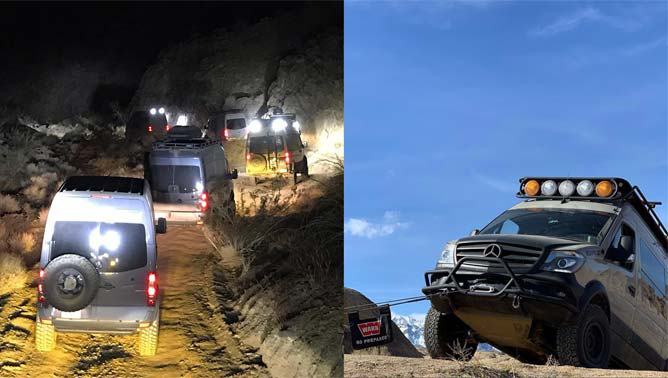The overland phenomenon has shaken up off-roading, and with the popularity of the 4×4 Sprinter Van, the adventure rig market will never be the same again. The once great rise (and subsequent fading) of mud bogging, then rock crawling, and various other “hardcore” 4×4 pastimes has been eclipsed by an ironic pair of forces.
First, the wicked speed, comfort, and all-around capabilities of the latest side-by-side UTVs have meant consumers are increasingly turning to ready-made RZRs and Can-Ams for exploring trails. Second, today’s multi-day adventure travel movement has unleashed a long-overlooked market segment that isn’t interested in high-banking, the Hammers, or Sand Hollow. Much of this sub-market is middle-aged, but still others are younger and seamlessly blend human-powered backcountry sports with off-road exploring. Perhaps like me, you’ve welcomed this shift.
While I’ve relished many days spent on tricky, technical trails, the problems with focusing on such routes go beyond dents and broken axles. Oftentimes, the real problem wasn’t tied to having a vehicle that was up to the challenge. Rather it was with finding a trail that even required you to engage a locker (let alone a 2nd one), since today’s 4x4s are so well-equipped from the factory, trails have steadily shrunk in relative difficulty.

More importantly, for many, many 4×4 owners, highly challenging trails have never been the point. Instead, they’re Ok with less extreme obstacles, because above all they want to see remote landscapes and explore them, they love to camp (for days if not weeks), and they want to be self-sufficient…all while remaining fairly comfortable.
Like it or not, these changes have led to a new question: what is the ultimate adventure rig today?
Fit for Adventure?
“Adventure is worthwhile in itself”, quipped Amelia Earhart (apparently paraphrasing Aesop). And adventure takes many forms. But it turns out, many, many, many miles of roads involve neither pavement nor many heroic obstacles. As a result, what is needed in a capable 4×4 (e.g., solid axles, box-on-frame construction, >33” tires) is being questioned now more than ever. What’s more, the vehicle that has most challenged the image of the ideal off-roader is none other than [gasp!] a van.
In reality, the rise of today’s so-called adventure van movement can be traced back decades. In fact, utility vans in general have been used for exploring long before any manufacturer added a front drive axle. This new genre likely began with the Russians. Specifically, their UAZ-450, in the late 1950s, may have been the very first 4×4 van. Still in production today, and still bearing a distinctly isolationist Cold War aesthetic, UAZ’s Bukhanka deserves the title of “grand-daddy of off-road vans.”
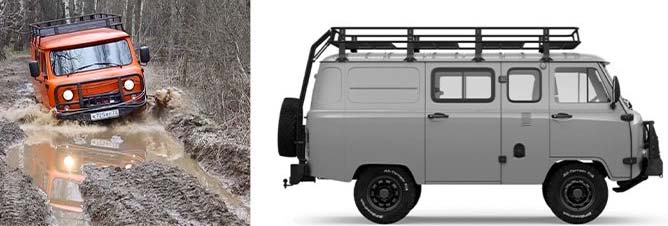
For North Americans, however, the roots of 4×4 vans is tied to conversions of passenger vans by industry icon Sportsmobile. Begun in 1961, the company met the tide of enthusiasm for hitting the American road—both paved and dirt—by custom up-fitting of Ford, Dodge, Chevy and, somewhat less known, VW vans. A decade later, the Texas-based company began swapping in true 4×4 systems on Ford Econoline models. In an age of deep pile carpet-lined “hippie-mobiles”, the result was a relatively roomy vehicle complete with kitchen, bed and, most uniquely, low range.
The innovative 1980’s brought VW’s Syncro van to the States, featuring a stunning mix of traction tech coupled (literally) with an underpowered engine (90hp) that only a Fahrvergnügen adherent could love. Designed and manufactured in collaboration with Steyr-Daimler-Puch, producer of the legendary Pinzgauer, the little Syncro delivered some serious off-pavement capabilities. Sadly, it was also limited to around 5,000 total units ever imported to our shores.
It’s fair to say that, despite the laudable efforts of VW, Sportsmobile and, to a lesser degree, Toyota, vans fit for off-pavement travel remained the ‘red-headed stepchild’ of the 4×4 world. Later offerings such as the AWD vans from Chevy (Astro) and Dodge/Chrysler (Caravan) merely helped owners reach ski slopes, and not market interests in off-pavement travel. But that has begun to change. Why? The ability to buy a true 4×4 van no longer relies on aftermarket customization.
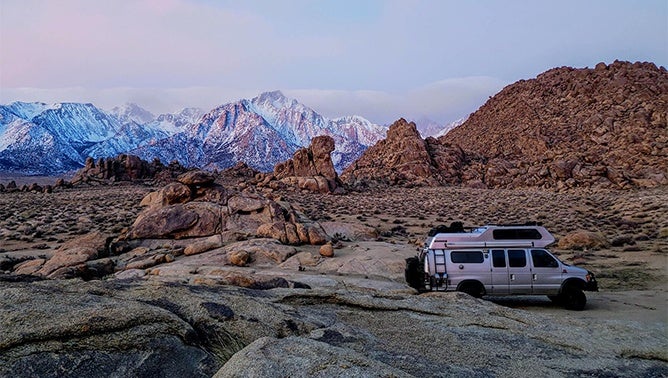
OEM Adventure Vans
Historically, to get a ½ or ¾ ton 4×4 van a buyer turned over the keys to Quigley or Sportsmobile for a drivetrain conversion. In recent decades, the number of companies offering similar retrofits on Ford and Chevy vans has expanded. The original Sportsmobile has seen its owners and locations split to be come SMB Vans West (California) and Sportsmobile (Texas & Indiana). Other major companies like Field Van in Fresno offer decades of experience. Smaller shops like U-Joint Off-road, Boulder Off-road Vans and Advanced 4×4 Vans have emerged in large numbers (and often faded away) to give buyers more adventure rig options.
Unfortunately, obtaining such a conversion remains pricey, often requires long waits, and, once completed, still wouldn’t allow an adult to stand up inside it (pop-top roofs are available but cost $7,000+). That all changed when Daimler-Benz announced in late 2014 it would begin bringing to U.S. markets the 4-wheel drive version of its (by then) extraordinarily successful utility van. Having first arrived in 2001, the initial fleet of 2wd Sprinters were entirely gobbled up by FedEx, a forgotten business decision that was prescient for the van’s future. By 2007, the 2nd generation of Sprinters had arrived, having lost the slant-nosed look of the prior T1N, and gained a new model designation: NCV3 (new concept vehicle 3).
Previously co-branded by the likes of Dodge and Freightliner in the States, the Sprinter was solely badged with the Mercedes tri-star emblem starting a decade ago. However, for those who prowl off pavement, the 2015 importing (and then assembling in its South Carolina plants) of the long-awaited 4×4 Sprinter (~2,000 total) began a new era. Specifically, a factory-equipped 4×4 option was offered on the numerous Sprinter models (low or high roofs, 3 wheelbase options, and dually options). And the outdoor recreation market responded immediately.
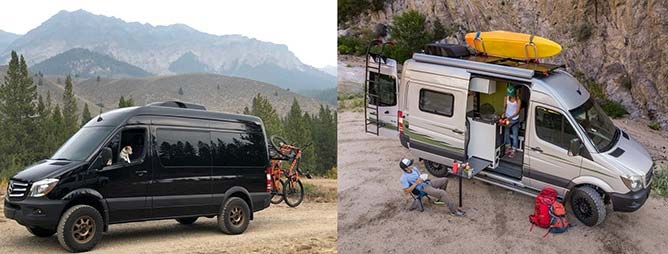
An(other) Off-Road Benz?
But was the Sprinter a “real 4×4”? Today, sadly, many who ask that question aren’t even sure what a true 4-wheel drive system entails. Simply put, it’s a system that allows the operator to select 2wd or 4wd, and (according to most enthusiasts) which is equipped with a selectable high/low range transfer case. And that, in fact, is just what the Sprinter’s 4×4 feature offered.
Originally adding $6800 to the sticker price (as well as a higher mounted body; 4.3” in front, 3.1” the rear), the 4×4 option split its larger 3.0L BlueTec turbo diesel’s abundant torque via a 35/65 distribution when in high range. A more trail-appropriate 50/50 split occurred when the odd little low range button (yes, a button) was depressed. In addition to the obvious traction gains, four-wheel drive also meant a set of 31” tires were fitted from the factory, and aggressive 32” tires would fit without any changes.
Built for the narrow, often snowy conditions of many European markets, which routinely require drivers to transition from city to muddy country tracks, the 4×4 Sprinter offers a nimbleness that must be experienced to be believed. Quite tall (some would say hulking), it looks more ungainly than apt to breed confidence in tight quarters. And yet the Sprinter was designed for Europe’s narrow, often ancient, streets. Whether in Germany, France or their neighboring EU countries, a premium is placed on maneuverability. In some towns, vehicles navigate routes so tight that two adults can spread arms and touch opposing building walls while still touching fingertips. In the early 1990’s, living in and exploring Tuscan hill towns, my wife and I often marveled at such cramped cobblestone streets.

Gifted with a surprisingly tight turning radius, the Sprinter (especially in the shortest 144” wheelbase) can negotiate mountain switchbacks nearly as well as European alleys. Combined with its 4×4 system, the result is a tall, boxy, yet maneuverable vehicle meant to drive in less-than-ideal conditions. In that sense, it’s reminiscent of its better known 4×4 brethren from the Mercedes line, the G-Wagen and UNIMOG.
Unlike a Ford or Chevy passenger van conversion, which essentially bolt up heavy duty 4×4 parts (e.g., DynaTrac solid front axle), the German engineers who planned the Sprinter were tasked with making a commercial utility vehicle and creating a platform with two drive options. That goal meant an ability to haul payloads up to 3,500lb, 4×4 drive that was safe to leave engaged at highway speeds, electronic Crosswind Assist (for controlling its high body/payload), and a fuel efficient 6-cylinder diesel powerplant with a projected lifespan approaching a half million miles.
In 2020, Mercedes celebrated the Sprinter’s 25th production year, having sold over 4 million of the vans in 130 countries. Today, the U.S. ranks as the #2 market for Sprinters in the world. And the four-wheel drive Sprinter has helped drive that phenomenon and has created its own firestorm of buying. So much so that there is currently a yearlong drought in the 4×4 models’ availability. Would-be buyers presently face waits of up to a year to buy a new one. But are high sales figures and consumer demand a sign that Sprinters are the ultimate adventure rig?
Why Adventure Vans Matter
While the #vanlife movement has taken the U.S. by storm, an eye-catching Instagram build doesn’t necessarily make for an off-road adventure rig. “Vehicle-dependent” adventure travel, in the words of renowned British explorer and author Tom Sheppard, reflects the broad desire to explore in ways that rely on tough motorized vehicles. Specifically, it is an activity that counts on properly selected and carefully prepared rigs.
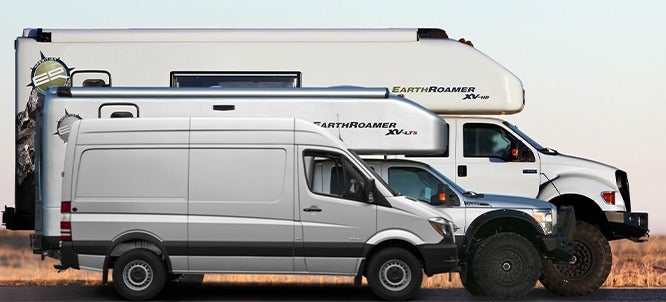
The adventure van market exists because selecting a vehicle to support the dream of exploration quickly runs headlong into two problems. First, today’s SUV’s and pickups are full of inconveniences and space limitations that pose challenges for travelers. Second, and at the other end of the economic (and size) spectrum, are the staggering price tags of so-called “expedition vehicles” from MAN, UNICAT, EarthCruiser and their lot. Adventure vans fill a gap between these two extremes.
Diverging from traditional U.S. cargo van design, the 4×4 Sprinter brought on a revolution with its high ceiling designs. So valuable were the benefits of the van’s tall body that Chevrolet and Ford effectively walked away from their dated 15-passenger vans (rollover liabilities no doubt contributed as well). In response, we now see their replacements—the Ram ProMaster and Ford Transit—conspicuously incorporating high ceilings, improved suspension stability, and, with the Ford, AWD.
What can we learn from these shifts? First, the lame FWD Ram shows how uncommitted Dodge is to the overland market. Second, Quigley is now offering to fix what FOMOCO got wrong with the insufficient, snow focused AWD system offered as a consolation prize on the Transit. As a result, the Sprinter continues to be the only option for purchasing a stock 4×4 van that can get you into (and through?) messy backcountry situations. But is that really surprising coming from Mercedes?
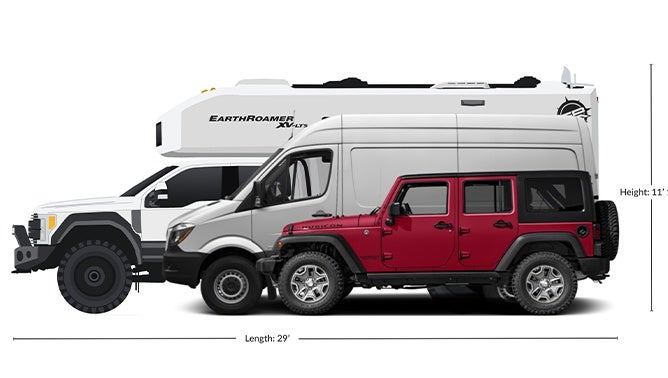
Yes, Mercedes resides in the pantheon of luxury car brands. And, yes, Mercedes is known for producing road racing champions like the C 9, which dominated at Le Mans, but remember, too, that Mercedes brought us two of the most respected and enduring military-grade 4×4’s in the world: the UNIMOG and G-Wagen. So, there can be no doubt that Daimler AG is more than capable of engineering a reliable off-road machine. Moreover, is it any wonder the 4×4 Sprinter captures the hopes and imagination of today’s adventure travel market?
Nonetheless, for many off-roaders, it seems heretical to even be discussing an “off-road van”. The reason for this feeling, I think, is tied to why we leave the pavement in the first place. Why do you enjoy off-roading?
For some of us, there’s an unspoken tug-of-war that arises between finding and tackling hard, technical trails, and actually traveling to remarkable places. The two goals are not always aligned. In fact, difficult routes often don’t go anywhere. They simply loop artificially around pockets of unique geology and terrain, producing a motorized version of what bouldering is for rock climbers: a set of short, technical challenges.
Conversely, breathtaking, remote landscapes are frequently crisscrossed with only mildly challenging two-tracks or well-graded dirt roads. As a result, whether we like to hear it or not, many, many 4×4’s are completely overbuilt for tackling the trails they encounter. They are outfitted for almost mythically hard adventures…that, alas, rarely occur.
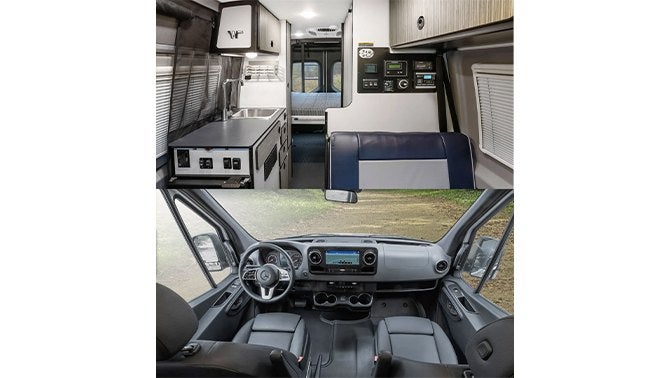
So specialized are these 4×4’s that they are poorly equipped for enjoying the typical, non-heroic trips. The hours spent in long-distance backcountry exploring benefits from other build priorities. But ultimately, perhaps there’s a deeper problem at play. The real fly-in-the-ointment may lie not in how overly-rugged our trucks are, but, rather, in how cramped they are.
Wakeup Call
To illustrate this point, consider the new Gladiator. The widely heralded addition to the Fiat Chrysler Automobiles line-up offers a scant 140cu ft of space (36cu ft for cargo, 104cu ft for its cabin). By comparison, in its shortest wheelbase (144”), a 2021 4×4 Sprinter offers more than double that volume for cargo alone…and that’s in the low roof model. The high roof, which most buyers prefer, boosts cargo space to 373cu ft. In the van’s most voluminous configuration (170” Extended model), that volume soars to nearly 600cu ft. [Factoid: An entire Jeep Wrangler 2-door, including tires, takes up about 335cu ft of space]
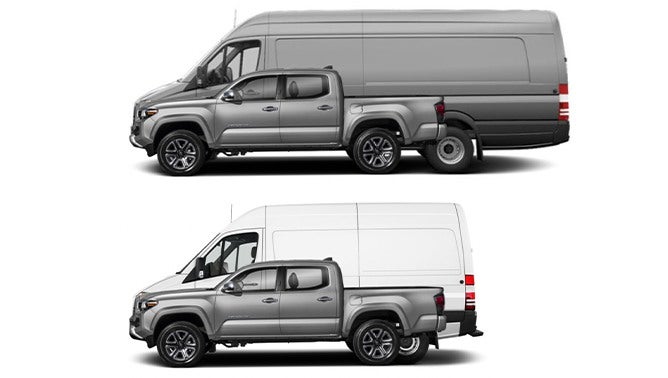
But sheer volume doesn’t tell the whole story. Ceiling height in the High Roof models is what transforms the Sprinter into a true living space. While the Gladiator, at 18’ long, won’t let you sleep inside (or in its “bed”), a 19.5’ Sprinter readily accommodates a literal queen size bed. Along with a galley, storage for a couple of mountain bikes, and seating for 4. All with headroom that permits a 6-footer like me to stand upright. These contrasts only become starker when shorter wheelbase SUV’s (e.g., Bronco, 4Runner) are compared to the Sprinter.
The significance of what this volume allows is better understood with a different comparison. Mercedes effectively brought the possibility of RV convenience into the backcountry with the unveiling of its slim but tall 4×4 Sprinter. At the same time, it made affordable many of the perks normally found on so-called global expedition vehicles that carry price tags from $250,000 to $1M. Those features include:
- cab-to-cabin pass through access,
- hard-sided exterior (for privacy, security and weather protection),
- seated dining/work areas,
- elevated operator position (49” seat height), and
- factory-engineered payload capacities approaching 2 tons [Note: Jeep Gladiator payload is ~1,200lb].
Last, but far from least, the Sprinter virtually cries out to be “built”. Its cavernous interior comes barebones in the Cargo configuration and is easily gutted if the Passenger version. Seats can be added, removed or arranged in new positions. Once empty, the chassis begs for weight to be added. Its ride quality was engineered for a couple thousand pounds of payload, so build it out, strap in a DR650, or haul a pallet of Sakrete. And, as importantly, the network for these vans is widespread.
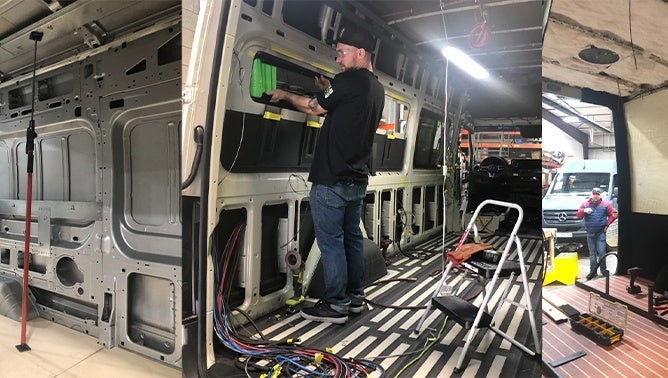
That last point, however, is referring to parts, skilled mechanics and 2WD models, and not the prevalence of used 4×4 models. Would-be buyers can expect to locate 20+ 2WD vans for everyone equipped with 4WD. As a result, prices for an unmodified, preowned 4×4 Sprinter with under 100k miles are rare for less than $40,000. New ones start at $60,000. The same models, if used and featuring only basic modifications, are routinely listed from $60,000 to $75,000. A properly outfitted model, ready for days of self-supported travel along the Mojave Road, White Rim Trail or Big Bend’s Black Gap Road, will cost from $85,000 to upwards of $150,000.
Need further proof that 4×4 Sprinters are the ultimate adventure rig? Winnebago announced its Revel version of the 144” 4×4 Sprinter in 2017. Selling today for $185,000, it’s a Class B motorhome that dares you to drive it off the beaten track. Not to be outdone, Thor Industries became the largest RV manufacturer in the world following its acquisition of the Erwin Hymer Group in Europe. As a result, Hymer USA will now begin bringing the company’s impressive Sprinter builds to our market. Whether we ever see its cool VisionVenture concept Sprinter or not, their Grand Canyon S CrossOver and ML-T CrossOver models (both4x4’s) appear to be on the way. Unlike the Revel, these vans offer lower axle gear ratios for more grunt. Estimated prices: $130,000 and $149,000.
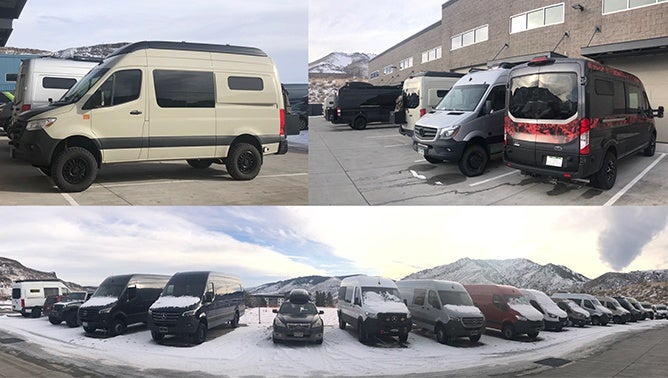
How are those prices so different from an EarthRoamer, you might ask? The Sprinter “up-fitting” market, a now widespread network of custom builders ready to take your stock van and prep it for adventure travel (and/or Instagram), has largely driven this shift. The complexities of a full van build-out, coupled with the understandable desire for a handsome and comfortable interior, means buyers face many, many more decisions and costs than even the most extensive Rubicon, Tacoma or Colorado build.
“Trail Rated” or Trailhead Rated?
Ready to make your Sprinter a trail beast? As you might have guessed, it’s in off-road performance products that the Sprinter market has little depth. At present, only two companies sell aftermarket lifts (both 2”, which allow 285/70r17 tires). Articulation is quite limited even after one of these expensive ($2,000-5,000) suspension options. No lockers or other traction devices are available in N. America (Germany has one company offering installs of their proprietary device).
In contrast, products that portray ruggedness, but offer secondary off-road benefits (e.g., recovery points, armor) are widespread. For instance, a buyer can choose from a half dozen or more winch bumpers for 2007-2018 Sprinters. Armor for the undercarriage can be had in aluminum or steel, and a plethora of roof rack designs let owners secure 300w+ of solar panels, while mounting enough lights to make Ivan Stewart jealous.
That irony—that Sprinters can be made to look so rugged, and yet few companies are addressing their main flaw: off-road capabilities—isn’t lost on many critics. These big vans risk being seen as “mall crawlers”, both for their overland bling, and for owners being unwilling to test their limits (can you blame them?), and ultimately sticking to trailheads and BLM roads.
So, what IS the 4×4 Sprinter capable of? Like most 4x4s, the answer is more than you think, and more than most owners will ever discover. I appreciate that Mercedes utilizes off-road test tracks to illustrate for journalists, and buyers alike, their van’s abilities. This video, shot at the famous Millbrook Proving Ground in Bedford, U.K., offers a glimpse of what a 144” 4×4 that’s factory equipped (albeit with XT tires) can traverse:
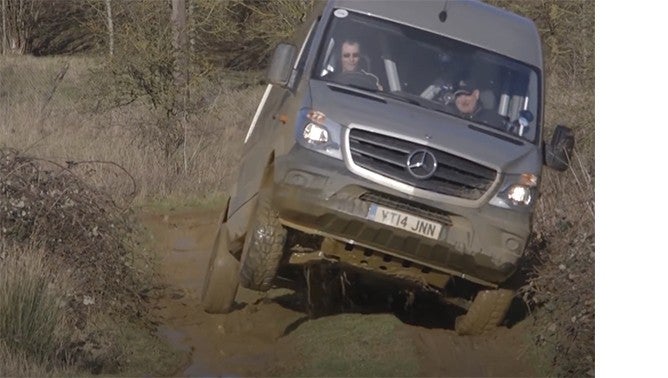
As the video shows, the stability of the Sprinter is impressive, as highlighted on the 25degree cross-slope test track. Likewise, its straight-line ascent/descent capabilities are enough to cause significant gravity-induced movement in the seat-o-the-pants. In the blunt 144” model, approach and departure angles are good (26 and 25 degrees, respectively).
To better grasp the 4×4 Sprinter, one should consider that a TRD 4Runner offers 33 and 25 degrees for the same angles, and only 1.6” of additional ground clearance over the Mercedes’ 8” minimum. It should be noted that fitting a 32” tires on the Sprinter is both easy and elevates the undercarriage to 9”. Taller tires require a bit more creative license with wheel well linings.
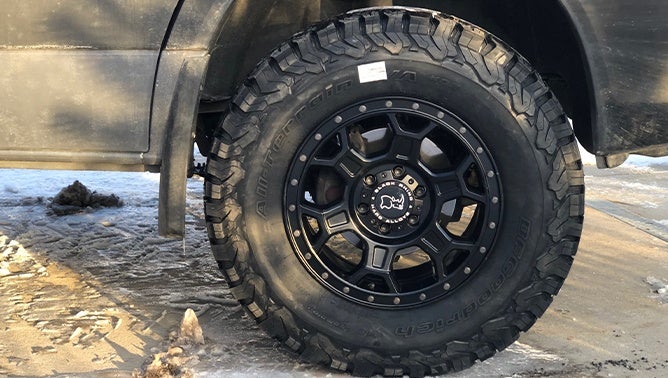
While ARB told me that ‘no Air Locker is in the works for the Sprinter (fore or aft), Mercedes didn’t completely ignore the need for grip on snow/sand/mud/gravel. Their 4ETS Electronic Traction System is, apparently, German for “the ABS lockers”. As sensors detect wheel slip, brakes are applied so that torque is redirected to tires having more grip on terra firma. With its Low Range providing a 42% lower “crawl ratio”, this system is no mere Subaru all-wheel drive.
- Pros – Build quality, torquey/efficient/long-lasting turbo diesel, numerous sizes, strong aftermarket of builders and manufacturers.
- Cons – Cost, limited off-road ability (poor articulation, 20:1 crawl ratio), no options for lockers/regearing, heavy and tall.
- Bottom Line – 4×4 Sprinters have effectively redefined adventure vans, combining enormous usable interior space, on/off-road drivability, and a platform for endless customization.
Need more serious trail capabilities but still want a 4×4 Sprinter’s roominess? German custom upfitter Iglhaut Allrad offers impressive built-to-order versions of the Sprinter. Starting with a 2WD van, their team fits a solid front axle, triple lockers, and 37” tires to produce today’s pinnacle of what these Teutonic beasts are capable of.
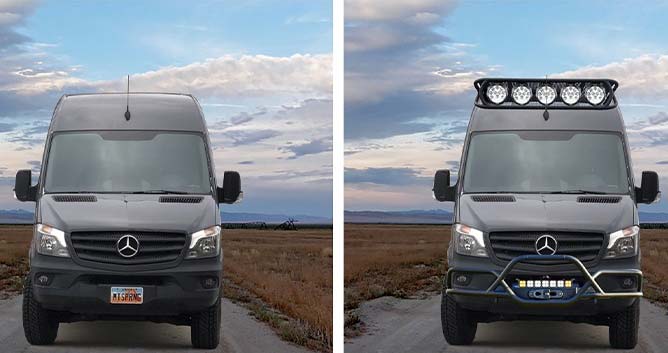
Real Sprinters are Built…Not Bought
So is a 4×4 Sprinter the “ultimate adventure rig”? For most who call themselves “off-roaders”, it’s hard to imagine they’ll rush to trade in a prized Jeep—which can easily cost $60,000—for a comparably priced 4×4 Sprinter. But it’s not the day-tripping rock crawler who wants or needs this type of rolling base camp. Instead, many who want to explore are less interested in hardcore obstacles, and more focused on minimizing camp setup, having hard-sided protection in nasty weather, and not having to strap gear on the rig’s exterior.
What is your ultimate adventure rig? If you add up the extras most owners spend on their 4×4’s, the costs to build a Sprinter differs little from traditional trucks. Vans raise the ceiling on comfort, but also build complexity, when compared to SUV’s and pickups. Where these vans can drain the wallet is the addition of endless RV-like comforts: a custom galley, bed, seating, shower/bath, etc.
For now, the 4×4 Sprinter remains among the most unique, under-appreciated, and overlooked of adventure vehicles. It opens doorways to new ways of exploring, and as important, it opens our mind to how we might, one day, want to roll out for the backcountry.
About the Gear Doctor: Dr. Sean Michael has been designing, abusing and testing outdoor gear since the 1980’s, and began reviewing products for Off-road.com in 2000. Today, he is Professor of Outdoor Product Design & Development at Utah State University, a product consultant, and a frequent Instructor at Overland Expo. Follow his trips and gear (ab)use @thegeardoctor on Instagram.
More 4×4 Sprinter Aftermarket Resources
Armor/Exterior:
Climate:
Interior:
Drifterwagons, Equipt, Imtra, Van Wife
Performance:
CAtuned, DTE Systems, Vision X
Power/Solar:
Expion360m, REDARC, Zamp Solar
Recovery:
ARB, Bubba Rope, Factor55, WARN
Seating/Bed:
Flarespace, scheel-mann, Travois USA
Upfitters:
